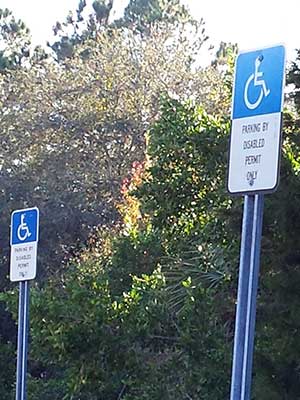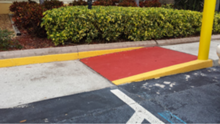Your Town
Getting Around. Transportation Options & Links
One of the toughest parts of living with a disability is becoming unable to “get around town” easily. The loss of vision, hearing or mobility can make it difficult or impossible to drive a car. How do you go grocery shopping? How do you go to doctor appointments? Depending on where we live our options can be very different and sometimes rather limited.
Streets and Sidewalks: Fortunately, the Americans with Disabilities Act (ADA) has fueled great improvements in how municipalities and their public transportation systems serve the disability community. Where communities have sidewalks, they are required to meet ADA guidelines. This includes having
- “curb-cuts” or “curb ramps” are short ramps cutting through a curb or built up to them. They provide a way to safely transition between a roadway and a curbed sidewalk.
- “detectable warnings” – i.e., dome-shaped bumps – are intended to alert blind individuals and those with low vision that they are about to enter a street or other area where cars pass.


Public Transportation: Fixed route buses in most cities have ramps designed for wheelchair, scooter or stroller access. Similarly, trains and subways almost always have ways for disabled passengers to reach loading platforms and safely enter their cars. Further, cities are required to provide paratransit services (special cars, vans or buses that serve citizens whose disabilities for whom using standard public transportation is too difficult) when possible. Local government offices typically can provide information about what is available.
Assistive devices for standard vehicles: There are many product types and brands that are designed to allow individuals with disabilities to continue driving safely. They can compensate for difficulties with moving and having reduced strength in hands or feet. It is always recommended that individuals work with occupational therapists or certified driver rehabilitation specialists. But depending on insurance coverage this can be expensive and difficult, so many individuals take a ‘do-it- yourself” approach. We know many examples of resourceful adaptations, but know that there can be liability risks when these are not “approved” by a trained professional or designated on our driver’s licenses. Regardless of which adaptations we use, it is imperative that we practice using them extensively and in safe locations (remote parking lots or quiet neighborhood streets). before venturing into higher traffic.

Permanent hand controls: Most of these must be installed by distributors and as such, almost universally do require training and certification. Although they are more expensive than portable controls, some funding may be available through charitable organizations.
Extenders for turn signals, emergency brake levers and shifters, Key adapters and more… Depending on your needs, there are many adaptation products to choose from.
Scooter or wheelchair lift: When transporting a wheelchair or scooter is needed, but buying a conversion vehicle is not a reasonable choice, buying a lift for the back of an existing vehicle can be an acceptable step. Because lifts and the mobility devices they carry change the weight distribution of a vehicle, it is important to work with a registered distributor / installer who can clear the lift’s safety with your vehicle manufacturer.
Conversion vehicle: These are available from several manufacturers and can be configured for hand control driving. New conversion vehicles can be very expensive. But there are quite a few used ones available from many of the new vehicle dealers.
No matter how you decide to travel around your town we wish you many safe, happy trips!
Bay News 9 Interview
Click on the video to see Bay News 9 Interview
Helpful Sites
- Taxi, Limousine and Paratransit Services
- American Public Transportation Association
- The Association for Driver Rehabilitation Specialists
- Portable Hand Controls
